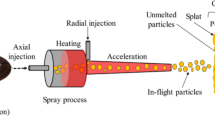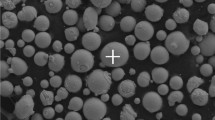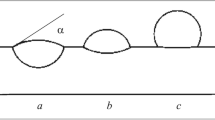The main purpose of this work was to determine the influence of laser treatment on microstructure, X-ray diffraction, microhardness, surface geometric structure, corrosion resistance, adhesion tests and tribological properties of coatings deposited on C45 carbon steel by the electro-spark deposition (ESD) process. The studies were conducted using WC–Cu electrodes produced by the powder metallurgy method. The tests show that the laser-treated electro-spark deposited WC–Cu coatings are characterized by higher corrosion resistance, adhesion, surface geometric structure and seizure resistance which result from lower microhardness. The laser treatment process causes the homogenization of the chemical composition, structure refinement and healing of microcracks and pores of the electro-spark deposited coatings. Laser treated ESD coatings can be applied in sliding friction pairs and as protective coatings.









Similar content being viewed by others
References
K. H. Ho and S. T. Newman, “State of the art electrical discharge machining,” Int.l J. Machine Tools & Manufacture, 43, No. 13, 1287–1300 (2003).
A. Miernikiewicz, Experimental and theoretical basis for EDM [in Polish], Monograph 274, Cracow, 2000.
D. D. DiBitonto, P. T. Eubank, M. R. Patel, and M. A. Barrufet, “Theoretical models of the electrical discharge machining process. I-A simple cathode erosion model,” J. Appl. Phys., 66, No. 9, 123–131 (1989).
I. V. Galinov, R. B. Luban, “Mass transfer trends during electrospark alloying,” Surf. Coat. Techn., 79, Nos. 1–3, 9–18 (1996).
N. Radek, “Determining the operational properties of steel beaters after electro-spark deposition,” Eksploatacja i Niezawodnosc – Maintenance and Reliability, 4, 10–16 (2009).
T. Chang-bin, L. Dao-xin, W. Zhan, and G. Yang, “Electro-spark alloying using graphite electrode on titanium alloy surface for biomedical applications,” Appl. Surf. Sci., 257, 6364–6371 (2011).
D. Ozimina, H. Scholl, and M. Styp-Rekowski, Forming of Anti-Wear Coatings by Electro-Spark Deposition [in Polish], Selected problems of energy beam focused treatment, Chapter 2, Bydgoszcz (2003).
N. Radek and A. Sládek, “Properties of electro-spark coatings deposited on the steel substrate using the tungsten carbide-ceramic electrodes,” Journal of the Balkan Tribological Association, 22, No. 2–I, 1354–1362 (2016).
B. R. Lazarenko, To invert the effect of wear on electric power contacts [in Russian], Dissertation of the All-Union Institute for Electro Technique in Moscow, Moscow (1943).
N. Radek, E. Wajs, and M. Luchka, “The WC–Co electrospark alloying coatings modified by laser treatment,” Powder Metall. Met. Ceram., 47, Nos. 3–4, 197–201 (2008).
N. Radek and B. Antoszewski, “Influence of laser treatment on the properties of electro-spark deposited coatings,” Kovove Materialy-Metallic Materials, 1, 31–38 (2009).
J. Pietraszek, N. Radek, K. Bartkowiak, “Advanced statistical refinement of surface layer’s discretization in the case of electro-spark deposited carbide-ceramic coatings modified by a laser beam,” Solid State Phenomena, 197, 198–202 (2013).
N. Radek and J. Konstanty, “Cermet ESD coatings modified by laser treatment,” Archives of Metallurgy and Materials, 57, No. 3, 665–670 (2012).
S. Adamczak, E. Miko, and F. Cus, “A model of surface roughness constitution in the metal cutting process applying tools with defined stereometry,” Strojniski Vestnik-Journal of Mechanical Engineering, 55, 45–54 (2009).
M. Scendo, “Potassium ethyl xanthate as corrosion inhibitor for copper in acidic chloride solutions,” Corros. Sci., 47, No. 7, 1738–1749 (2005).
M. Scendo, “Corrosion inhibition of copper by potassium ethyl xanthate in acidic chloride solutions,” Corros. Sci., 47, No. 11, 2778–2791 (2005).
Author information
Authors and Affiliations
Corresponding author
Additional information
Published in Poroshkova Metallurgiya, Vol. 57, Nos. 5–6 (521), pp. 87–96, 2018.
Rights and permissions
About this article
Cite this article
Radek, N., Scendo, M., Pliszka, I. et al. Properties of Electro-Spark Deposited Coatings Modified Via Laser Beam. Powder Metall Met Ceram 57, 316–324 (2018). https://doi.org/10.1007/s11106-018-9984-y
Received:
Published:
Issue Date:
DOI: https://doi.org/10.1007/s11106-018-9984-y




